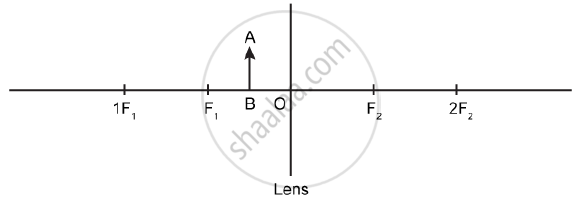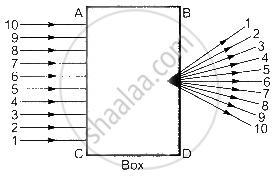Advertisements
Advertisements
Question
Object at 2F1 of a convex lens : Image at 2F2 : : Object at F1 : _______
Solution
Object at 2F1 of a convex lens : Image at 2F2 : : Object at F1 : Image at infinity
APPEARS IN
RELATED QUESTIONS
One-half of a convex lens is covered with a black paper. Will this lens produce a complete image of the object? Verify your answer experimentally. Explain your observations.
Draw a ray diagram to show the formation of the image of an object be placed so that a real and inverted image of the same size as the object is obtained using a convex lens
An object AB is placed between O and F1 on the principal axis of a converging lens as shown in the diagram.

Copy the diagram and by using three standard rays starting from point A, obtain an image of the object AB.
Complete the following table:
| Instrument | Number of Convex Lenses |
Use |
| Simple Microscope | .............. | .............. |
| Compound Microscope | .............. | .............. |
| Telescope | .............. | .............. |
A ray of light travelling in water emerges into air. Draw a ray-diagram indicating the change in its path.
For what position of an object a real, diminished image is formed by a convex lens?
State any two uses of convex lenses.
With the help of a labelled diagram explain how a convex lens converges a beam of parallel light rays. Mark the principal axis, optical centre, principal focus and focal length of the convex lens on the diagram.
Three convex lenses are available having focal lengths of 4 cm, 40 cm and 4 m respectively. Which one would you choose as a magnifying glass and why?
What is the position of image when an object is placed at a distance of 10 cm from a convex lens of focal length 10 cm?
Describe the nature of image formed when an object is placed at a distance of 30 cm from a convex lens of focal length 15 cm.
Find the position and nature of the image of an object 5 cm high and 10 cm in front of a convex lens of focal length 6 cm.
A convex lens of focal length 15 cm produces a magnification of +4. The object is placed:
(a) at a distance of 15 cm
(b) between 15 cm and 30 cm
(c) at less than 15 cm
(d) beyond 30 cm
An object 50 cm tall is placed on the principal axis of a convex lens. Its 20 cm tall image is formed on the screen placed at a distance of 10 cm from the lens. Calculate the focal length of the lens.
What kind of lens can form:
an inverted diminished image?
An image formed on a screen is three times the size of the object. The object and screen are 80 cm apart when the image is sharply focussed.
State which type of lens is used.
What type of lens is used to correct
hypermetropia
In a certain murder investigation, it was important to discover whether the victim was long-sighted or short-sighted. How could a detective decide by examining his spectacles?
A parallel oblique beam of light falls on a convex lens. Draw a diagram to show the refraction of light through the lens.
The focal length of a thin convex lens is ______ than that of a thick convex lens.
Where is the image formed?
A lens forms an erect, magnified, and virtual image of an object. Name the type of lens.
A convex lens forms an image of an object equal to the size of the object. State two more characteristics of the image.
In the following cases, where must an object be placed in front of a convex lens so that the image formed is upright and enlarged?
An object is placed perpendicular to the principal axis of a convex lens of focal length 20 cm. The distance of the object from the lens is 30 cm. Find (i) the position (ii) the magnification and (iii) the nature of the image formed.
Draw neat diagram to show the
Convergent action of a convex lens,
Answer the following question.
List four precautions which a student should observe while determining the focal length of a given convex lens by obtaining an image of a distant object on a screen.
An object 4.0 cm in size, is placed 25.0 cm in front of a concave mirror of focal length 15.0 cm.
(i) At what distance from the mirror should a screen be placed in order to obtain a sharp image?
(ii) Find the size of the image.
(iii) Draw a ray diagram to show the formation of the image in this case.
Point out the difference between a convex lens and a concave lens.
State the position of object, position of image, nature of image when: Convex lens is used in observing biological specimens.
Define the principal focus of a convex lens.
Write the name.
The lens used in simple microscope.
A beam of light is incident through the holes on side A and emerges out of the holes on the other face of the box as show in the figure. Which of the following could be inside the box?

Which of the following statements is true?
- In which type of microscope do you find the lens arrangement as shown in the following diagram?

- Write about the working and the use of this microscope.
Distinguish between Concave lens and Convex lens.
Distinguish between:
Concave lens and Convex Lens
Distinguish between:
Concave lens and Convex Lens
Distinguish between:
Concave lens and Convex lens
